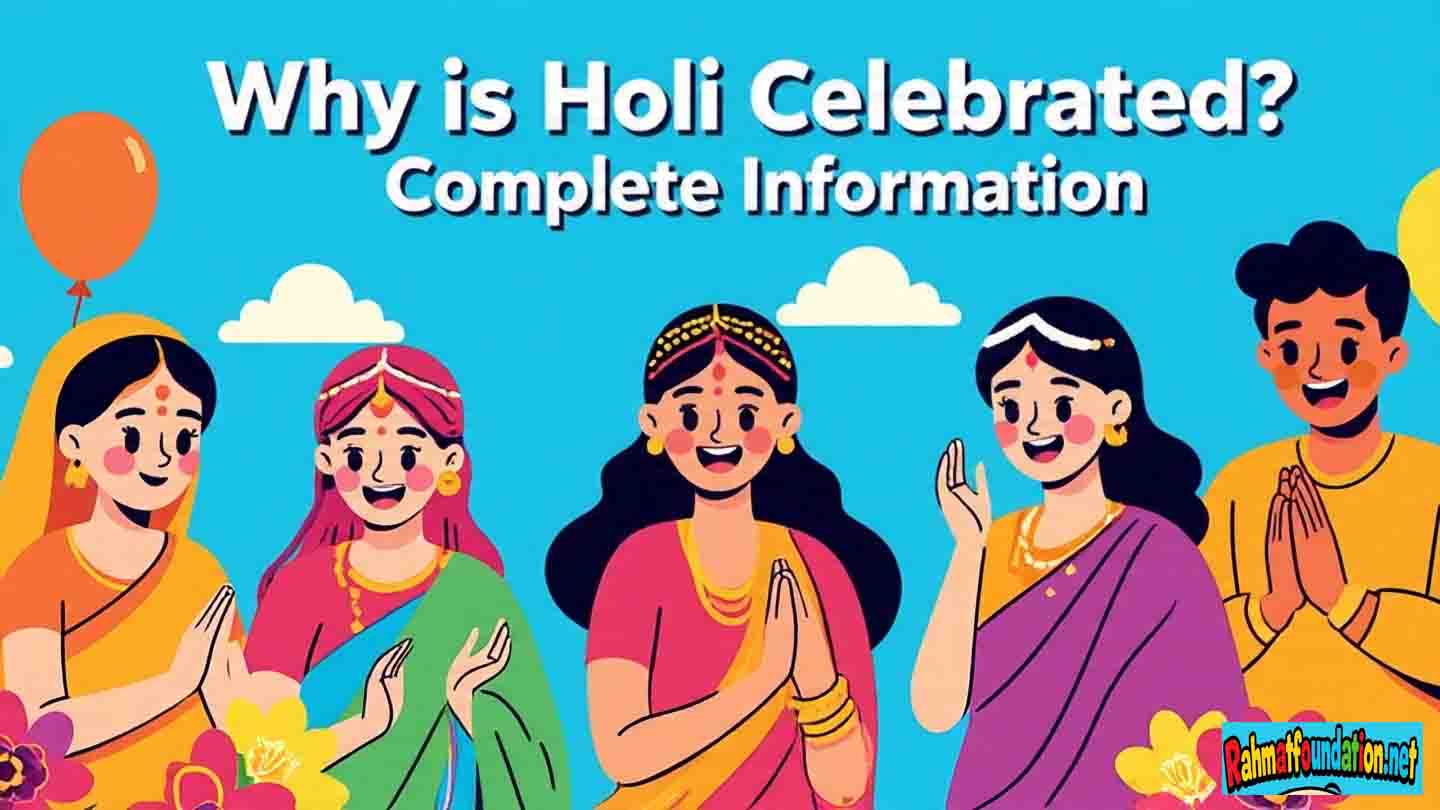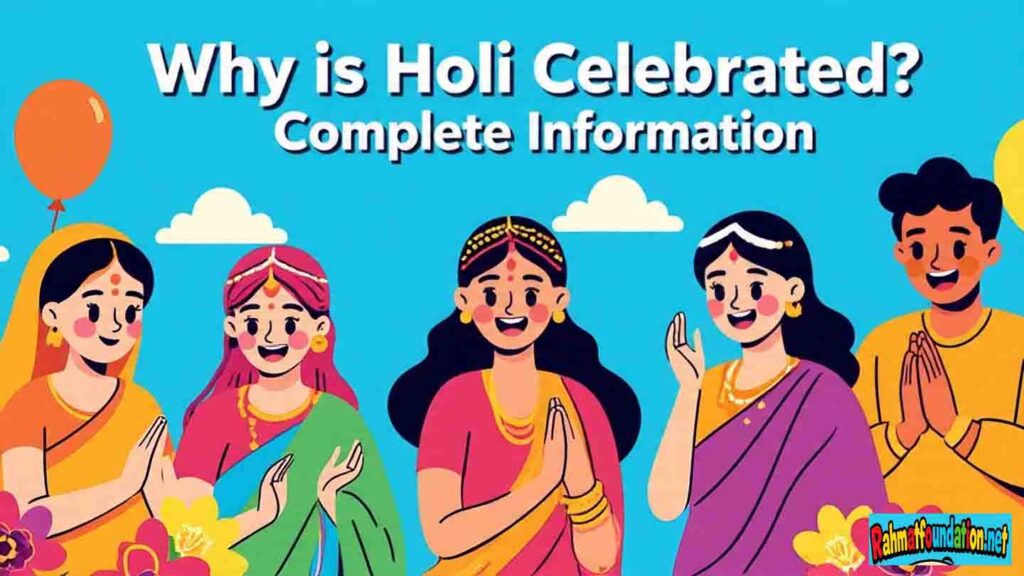Why is Holi Celebrated? Complete Information

1. Introduction: Why is Holi Celebrated?
Holi, popularly known as the Festival of Colors, is one of the most vibrant and joyous festivals celebrated primarily in India and Nepal. But why is Holi celebrated? The festival marks the arrival of spring and signifies the victory of good over evil. It is celebrated with enthusiasm by people of all ages who come together to throw colored powders, sing, dance, and enjoy festive foods. However, the true significance of Holi goes far beyond fun and frolic.
The essence of Holi lies in its rich mythological history, cultural traditions, and its role in promoting unity and togetherness. In this comprehensive guide, we will explore the multiple layers of Why is Holi Celebrated, including historical events, mythological stories, cultural practices, modern trends, and eco-friendly ways to celebrate.
Table of Contents

2. The Historical Background of Holi
The origins of Holi can be traced back to ancient times in India, where it began as a traditional celebration of seasonal change and spiritual legends. It is believed that the festival originated as a celebration of the harvest season, welcoming spring and bidding farewell to winter. Agricultural communities celebrated Holi to thank the gods for a good harvest and to seek prosperity in the coming seasons.
Over time, Holi evolved into a festival with religious and mythological significance. Ancient scriptures and folklore narrate various stories associated with the celebration of Holi, some of which have been passed down through generations.
👉 Read more about Holi’s history on Britannica (DoFollow External Link)
3. The Mythological Significance of Holi
The Legend of Holika and Prahlad
One of the most well-known mythological stories behind Holi is the tale of Prahlad and Holika. According to Hindu mythology, King Hiranyakashipu was a tyrant who demanded that everyone worship him as a god. However, his son, Prahlad, was a devout follower of Lord Vishnu and refused to obey his father’s orders.
Hiranyakashipu’s sister, Holika, who was immune to fire, sat with Prahlad in a blazing fire in an attempt to kill him. However, Prahlad’s unwavering devotion to Lord Vishnu saved him, and Holika was burnt to ashes. This event symbolizes the victory of good over evil and is commemorated by Holika Dahan, a ritual where bonfires are lit on the eve of Holi.
The Celebration of Lord Krishna and Radha
Another significant legend is related to Lord Krishna and Radha. Young Krishna, known for his playful and mischievous nature, used to play Holi with Radha and the gopis (cowherd girls) in Vrindavan. He would smear colors on Radha and others, which became a symbol of love and joy. This tradition continues to be a major part of Holi celebrations.
4. How is Holi Celebrated Across India?
Holi is celebrated with diverse customs across different regions of India, reflecting the cultural diversity of the country.
North India
In states like Uttar Pradesh, Punjab, and Delhi, Holi is celebrated with great pomp. People gather in open fields and streets to play with colors (gulal), water balloons, and water guns. Celebratory music and lively dance play a central role in bringing the vibrant spirit of Holi to life. The night before Holi, Holika Dahan is performed by lighting bonfires.
West India
In Maharashtra and Gujarat, the festival is celebrated with traditional folk songs, dances like Garba, and throwing of colors. Special sweets like gujiyas and malpua are prepared.
East India
In West Bengal and Odisha, Holi is celebrated as ‘Dol Jatra’ or ‘Dol Purnima’, which is closely associated with Krishna worship. Devotees carry idols of Lord Krishna and Radha and sing devotional songs.
South India
Though Holi is less widespread in South India, some regions do celebrate it in smaller forms, primarily focusing on religious rituals and cultural programs.
5. The Cultural Impact of Holi
Holi is not just a religious or agricultural festival; it has deep cultural significance. The festival promotes social harmony by breaking down barriers of caste, creed, age, and gender. People forget past grievances and come together in a spirit of unity.
Holi also inspires various forms of art, music, dance, and literature. Folk songs related to Holi are immensely popular, and in modern times, Bollywood has immortalized Holi in famous songs and movies, spreading its appeal worldwide.
6. Modern-Day Holi: Trends and Global Celebrations
In recent decades, Holi has gained global recognition. It is celebrated in countries like the United States, United Kingdom, Canada, Australia, and even Japan, primarily by the Indian diaspora and enthusiasts of Indian culture.
Modern Holi celebrations often include organized events such as Holi festivals of colors, combining music, dance, and color throwing in large open spaces or community centers. These events emphasize fun and enjoyment but still carry the essence of the traditional festival.
However, it is important to maintain the true spirit of Holi rather than reducing it to a mere party. The focus should be on spreading love, happiness, and cultural heritage.
7. Holi Safety and Eco-Friendly Celebrations
With the growing awareness of environmental and health issues, celebrating an eco-friendly Holi has become vital.
Eco-Friendly Tips for Holi:
- Use natural, organic colors made from flowers, turmeric, and other safe ingredients.
- Avoid synthetic and chemical-laden colors to prevent skin allergies and water pollution.
- Prefer waterless Holi or use minimal water.
- Dispose of waste properly and avoid plastic balloons or packaging.
🌱 Learn more about eco-friendly Holi practices (DoFollow External Link)
Safety Measures:
- Supervise children while playing with colors.
- Do not throw colors in someone’s eyes or force people to participate.
- Be mindful of elderly people and pets during celebrations.
- Use safe fireworks or avoid them altogether to reduce air and noise pollution.
8. The Social Message Behind Holi
The deeper message of Holi is unity, love, and the triumph of good over evil. It reminds us to let go of past grudges, forgive others, and embrace the joy of togetherness. The festival bridges social and economic divides and encourages harmony in society.
At organizations like Rahmat Foundation, we promote the social aspects of Holi by organizing community events that include underprivileged children, fostering a spirit of inclusiveness and joy.
9. Holi Recipes and Festive Foods
No festival is complete without special dishes, and Holi is no exception. Some popular Holi delicacies include:
- Gujiyas – Sweet dumplings filled with khoya and dry fruits.
- Thandai – A cool and flavorful beverage made from milk, infused with a blend of aromatic nuts and traditional spices.
- Malpua – Sweet pancakes soaked in sugar syrup.
- Puran Poli – A sweet stuffed flatbread popular in Maharashtra.
These foods not only add flavor to the celebrations but also represent the richness of Indian culinary traditions.
10. Conclusion: The True Spirit of Holi
In conclusion, Why is Holi Celebrated? Complete Information reveals that Holi is much more than colors and fun. It is a celebration of life, nature, and humanity. Rooted in mythological stories and agricultural traditions, Holi carries messages of unity, compassion, and renewal.
Let us embrace Holi in its true spirit — responsibly, joyfully, and with a heart full of love.
11. Frequently Asked Questions (FAQs)
Q1: What is the significance of Holika Dahan?
A: Holika Dahan symbolizes the victory of good over evil and commemorates the tale of Prahlad and Holika.
Q2: Can Holi be celebrated without using water and colors?
A: Yes, many people opt for a dry Holi or light celebrations focusing on music, dance, and sweets to reduce water wastage and pollution.
Q3: Is Holi celebrated globally?
A: Yes, Holi is celebrated in various countries due to the Indian diaspora and growing interest in Indian culture.